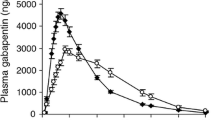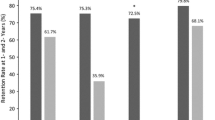Abstract
Background
In three randomized double-blind clinical trials, lamotrigine extended-release (lamotrigine XR) was demonstrated to be effective in the adjunctive treatment of intractable partial seizures or primary generalized tonic-clonic seizures and as monotherapy for partial seizures.
Objective
A pooled analysis of the data from these three clinical trials was performed to determine whether the tolerability and safety profile of lamotrigine XR was similar to lamotrigine immediate-release (lamotrigine IR).
Methods
This report describes results of a pooled analysis of the tolerability and safety data from the double-blind and open-label phases of these three trials. The number of patients in the integrated database exposed to one or more doses of lamotrigine XR was 662.
Results
Duration of exposure to lamotrigine XR was ≥26 weeks in 82.5 % of patients and ≥52 weeks in 40.8 % of patients [mean (standard deviation) 39.8 (23.3) weeks]. The number of patients with one or more adverse events during double-blind or open-label treatment was 455 (69 %). The most common treatment-emergent adverse events, regardless of suspected cause, were headache (25 % of patients) and dizziness (16 % of patients). The number of patients with one or more adverse events considered to be reasonably attributed to lamotrigine XR during double-blind or open-label treatment was 202 (31 %). The most common adverse events considered to be reasonably attributed to lamotrigine XR were dizziness (10 % of patients) and headache (6 % of patients). Lamotrigine-attributed rash was reported in 4 % of patients and was the reason for premature withdrawal in 2 %. Adverse events leading to premature withdrawal were reported in 7 % of patients. The incidence of serious lamotrigine-attributed adverse events was 1 %. One case of serious rash was reported. No cases of rash were reported to be Stevens–Johnson syndrome or toxic epidermal necrolysis. Two deaths (acute cardiac failure and acute lamotrigine poisoning) were considered reasonably attributable to lamotrigine XR. No evidence of lamotrigine-attributed changes was observed in clinical laboratory data or vital signs.
Conclusion
The results show that lamotrigine XR is well tolerated with safety and tolerability profiles similar to those of lamotrigine IR. Given the similar safety, tolerability and efficacy profiles of lamotrigine XR and lamotrigine IR, the extended-release formulation may be preferable for many patients because of its ease of use (with once-daily dosing regardless of concomitant antiepileptic drug), the potential for enhanced compliance with once-daily dosing, and the provision of more stable serum drug concentrations. The benefit of once-daily dosing must be balanced with the potentially greater negative impact of a missed dose.
Similar content being viewed by others
References
LAMICTAL (lamotrigine tablets) prescribing information. GlaxoSmithKline: September 2011. http://www.gsk.com/products/prescription-medicines/lamictal.htm. Accessed 25 Oct 2011.
LAMICTAL XR (lamotrigine) extended-release tablets prescribing information. GlaxoSmithKline: September 2011. http://www.gsk.com/products/prescription-medicines/lamictal.htm. Accessed 25 Oct 2011.
Tompson DJ, Ali I, Oliver-Willwong R, et al. Steady-state pharmacokinetics of lamotrigine when converting from a twice-daily immediate-release to a once-daily extended-release formulation in subjects with epilepsy (the COMPASS study). Epilepsia. 2008;49:410–7.
Rheims S, Ryvlin P. Once-daily lamotrigine extended release for epilepsy management. Expert Rev Neurother. 2009;9:167–73.
Claxton AJ, Cramer J, Pierce C. A systematic review of the associations between dose regimens and medication compliance. Clin Ther. 2001;23:1296–310.
Cramer J, Vachon L, Desforges C, et al. Dose frequency and dose interval compliance with multiple antiepileptic medications during a controlled clinical trial. Epilepsia. 1995;36:1111–7.
Garnett WR. Antiepileptic drug treatment: outcomes and adherence. Pharmacotherapy. 2000;20:191S–9S.
Buck D, Jacoby A, Baker GA, Chadwick DW. Factors influencing compliance with antiepileptic drug regimes. Seizure. 1997;6:87–93.
Cramer JA, Glassman M, Rienzi V. The relationship between poor medication compliance and seizures. Epilepsy Behav. 2002;3:228–42.
Williams J, Lawthom C, Dunstan FD, et al. Variability of antiepileptic medication-taking behaviour in sudden unexplained death in epilepsy: hair analysis at autopsy. J Neurol Neurosurg Psychiatry. 2006;77:481–4.
Naritoku DK, Warnock CR, Messenheimer JA, et al. Lamotrigine extended-release as adjunctive therapy for partial seizures. Neurology. 2007;69:1610–8.
Biton V, DiMemmo J, Shukla R, et al. Adjunctive lamotrigine XR for primary generalized tonic-clonic seizures in a randomized, placebo-controlled study. Epilepsy Behav. 2010;19:352–8.
French JA, Temkin N, Shneker BF, et al. Lamotrigine XR conversion to monotherapy: first study using a historical control group. Neurotherapeutics. 2012;9:176–84.
ICH Harmonised Tripartite Guideline. The extent of population exposure to assess clinical safety of drugs intended for long-term treatment of non-life-threatening conditions. E1. 27 October 1994. http://www.ich.org/fileadmin/Public_Web_Site/ICH_Products/Guidelines/Efficacy/E1/Step4/E1_Guideline.pdf. Accessed 25 Oct 2011.
Messenheimer J, Mullens EL, Giorgi L, et al. Safety review of adult clinical trial experience with lamotrigine. Drug Saf. 1998;18:281–96.
Keranen T, Sivenius J. Side effects of carbamazepine, valproate and clonazepam during long-term treatment of epilepsy. Acta Neurol Scand Suppl. 1982;97:69–80.
Dhalla Z, Bruni J, Sutton J. A comparison of the efficacy and tolerability of controlled-release carbamazepine with conventional carbamazepine. Can J Neurol Sci. 1991;18:66–8.
Werz MA. Pharmacotherapeutics of epilepsy: use of lamotrigine and expectations for lamotrigine extended release. Ther Clin Risk Manag. 2008;4:1035–46.
Blaszczyck B, Czuczwar SJ. Efficacy, safety, and potential of extended-release lamotrigine in the treatment of epileptic patients. Neuropsychiatr Dis Treat. 2010;6:145–50.
Steinbaugh L, Szaflarski JP. Adjunctive therapy for the treatment of primary generalized tonic-clonic seizures: focus on once-daily lamotrigine. Drug Des Devel Ther. 2010;4:337–42.
Acknowledgments
The authors acknowledge Jane Saiers, PhD (The WriteMedicine, Inc.) for assistance with writing this manuscript. Dr Saiers’ work was funded by GlaxoSmithKline. Authors John Messenheimer and Paul Caldwell were employed by GlaxoSmithKline at the time the studies were conducted.
Author information
Authors and Affiliations
Corresponding author
Rights and permissions
About this article
Cite this article
Biton, V., Shneker, B.F., Naritoku, D. et al. Long-Term Tolerability and Safety of Lamotrigine Extended-Release: Pooled Analysis of Three Clinical Trials. Clin Drug Investig 33, 359–364 (2013). https://doi.org/10.1007/s40261-013-0070-4
Published:
Issue Date:
DOI: https://doi.org/10.1007/s40261-013-0070-4




